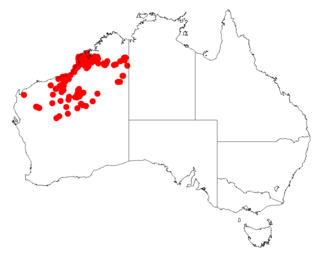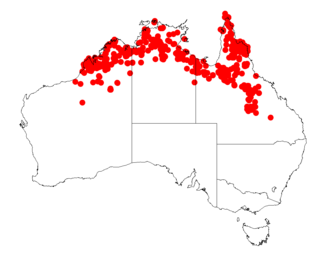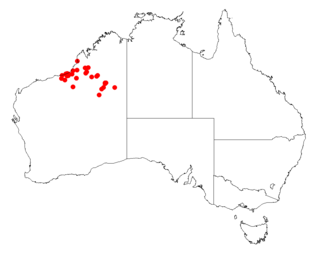
Terminalia catappa is a large tropical tree in the leadwood tree family, Combretaceae, that grows mainly in the tropical regions of Asia, Africa, and Australia. Common names in English include country almond, Indian almond, Malabar almond, sea almond, tropical almond, beach almond and false kamani.

Nothofagus cunninghamii, the myrtle beech, is an evergreen tree native to Tasmania and Victoria, Australia. It grows mainly in the temperate rainforests, but also grows in alpine areas. It is not related to the Myrtle family. It is often referred to as Tasmanian myrtle within the timber industry. N. cunninghamii was proposed to be renamed Lophozonia cunninghamii in 2013. There has been some controversy over the change in name from Nothofagus to Lophozonia.
Terminalia ferdinandiana, also called the gubinge, billygoat plum, Kakadu plum, green plum, salty plum, murunga or mador, is a flowering plant in the family Combretaceae, native to Australia, widespread throughout the tropical woodlands from northwestern Australia to eastern Arnhem Land. It has a high concentration of vitamin C in its fruit: recorded concentrations of 2300–3150 mg/100 g wet weight and occasionally as high as 5300 mg/100 g, compared with 50 mg/100 g for oranges, ranks among the highest known of any natural source.

Verticordia cunninghamii, commonly known as tree featherflower or liandu, is a flowering plant in the myrtle family, Myrtaceae and is endemic to an area in the extreme north of Western Australia and the Northern Territory. It is a spindly shrub or small tree with narrow leaves and cream to white, sweetly scented, feathery flowers.

Adenanthos × cunninghamii, commonly known as woollybush, Albany woollybush or prostrate woollybush, is a hybrid shrub in the family Proteaceae. It is endemic to the south-west of Western Australia.

The Kimberley tropical savanna is a tropical and subtropical grasslands, savannas, and shrublands ecoregion in northwestern Australia, covering portions of Western Australia and the Northern Territory south of the Timor Sea.

Pindan is a name given to the red-soil country of the south-western Kimberley region of Western Australia. The term comes from a local language and applies both to the soil and to the vegetation community associated with it.

Acacia tumida, known colloquially as pindan wattle, spear wattle or wongai, is a species of Acacia native to northern and western Australia.

Acacia eriopoda, commonly known as the Broome pindan wattle and the narrow-leaf pindan wattle, is a species of wattle in the legume family that is native to northern Western Australia. It is also known as Yirrakulu to the Nyangumarta peoples.

Acacia platycarpa, commonly known as the pindan wattle or ghost wattle, is a species of plant in the legume family that is native to northern Australia from Western Australia through the Northern Territory to Queensland.

Lysiphyllum cunninghamii is a species of plant in the family Fabaceae. It is native to northern Australia where it occurs from Western Australia through the Northern Territory to Queensland.
Premna acuminata, commonly known as the firestick tree, or ngalinginkil in the Bardi language, is a species of plant in the mint family. It is native to northern Australia where it occurs from Western Australia through the Northern Territory to Queensland.

Acacia ancistrocarpa, commonly known as fitzroy wattle, is a shrub belonging to the genus Acacia and the subgenus Juliflorae. The shrub is also known as fish hook wattle, pindan wattle and shiny leaved wattle.

Acacia anaticeps, also known as duck-headed wattle, is a shrub or tree of the genus Acacia and the subgenus Plurinerves. It is native to arid areas of north western Australia.
Terminalia canescens, commonly known as joolal or winged nut tree, is a tree of the family Combretaceae native to northern parts of Australia.
Terminalia grandiflora, commonly known as yalu, plumwood or nutwood, is a tree of the family Combretaceae native to northern Australia. The Nungali and Jaru peoples know the tree as badgari and the Wagiman know it as barnyin.

Terminalia hadleyana is a tree of the family Combretaceae native to northern Australia.
Terminalia latipes is a tree of the family Combretaceae native to northern Australia.
Terminalia volucris, commonly known as rosewood, is a tree of the family Combretaceae native to northern Australia.

Acacia tropica is a shrub or small tree native to tropical areas northern Australia.













